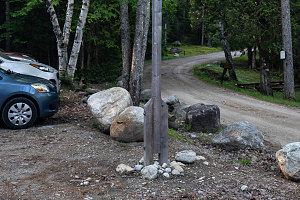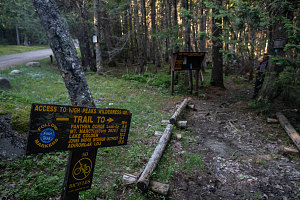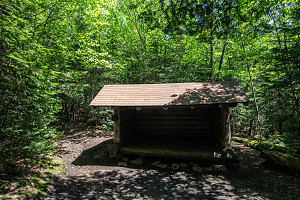Over the past twelve months or so, my outings to the Adirondacks have been very short and easy. If you add them all together, in fact, you'll see that the average outing has only been about 8-9 kilometers (5 miles) in length, about 4 hours in duration, and less than 2000 feet of elevation gain. Easy stuff.
Today's outing busted free of that particular prison: a journey from the Elk Lake trailhead, far on the southern fringes of the High Peaks region, all the way to the summit of remote Mount Skylight. And then all the way back. A route I'd never done before. By my rough calculations, it was a hike that would be in excess of 32 kilometres in length (20 miles) and about 4000 feet of elevation. And definitely longer than four hours of duration!!

Elk Lake Trailhead
Apart from just wanting to do something more challenging, there was another reason for a more hard-core outing: Brian and I were preparing for a July journey out west, one that would see us (once again) attempting to summit one of the more remote of the Cascade Volcanos in Washington State: Glacier Peak. Climbing Glacier Peak involves a rather lengthy backpack approach, and getting a few long and high outings in before our attempt was -- in my opinion -- a very good idea.

Our trailhead across road
I chose Skylight - the Adirondacks' fourth-highest peak - because it involved a long hike, because I hadn't visited it in over ten years, and because... it's a really nice summit! Additionally, doing it this way - from the south - involved some trail that I'd never hiked before.
Climbing Skylight from the south means you park at the Elk Lake Trailhead, reached by driving up the Elk Lake Road, which itself connects to State highway 84 (aka Blue Ridge Road). This southern fringe of the High Peaks is much quieter and less visited than the busy northern and eastern trailheads (like ADK Loj, The Garden, etc).
However, the Elk Lake parking lot is very small - maybe only enough space for 15 cars or so. And if it's full, which it can be on nice weekends, then the next permissable parking area is 2 MILES back from the trailhead. That was not something I wanted to have happen, so... we left Ottawa very early (3:45 a.m.) and arrived shortly after 7 a.m. Fortunately, there were about 3 or 4 spots free (I've heard that it is not impossible for this trailhead to be full by 8 a.m).

We were saddled up and on the trail by 7:20 a.m. There are two trailheads leading away from the Elk Lake hiker parking lot: one eastwards towards the Dix Range, and the other westward. We took the much less travelled western trailhead, and immediately we started walking on a springy forest floor path, rather than a wide, hard-packed track. And, after a few minutes of hiking, we descended down to our first major water crossing: a slightly wobbly suspension bridge across a small river known as "The Branch". The Branch drains nearby Elk Lake.

The Branch Bridge
After crossing The Branch, we came to a series of old roads through the forest, and small but fairly clear set of trail signs directed us here and there through the various intersections. The area around Elk Lake is mostly owned by the Elk Lake Lodge company, and these old forest roads are on that land. The NYSDEC (the state authority that maintains and operates the trail network in the Adirondacks) has a right-of-way through this private land - and these trail signs (which are distinct from the white-colored Elk Lake Lodge signs) - were guiding us through.
Another non NYSDEC turnoff
The land around Elk Lake is quite gentle and generally fairly flat. Because of that, and because we were essentially following old road-beds, the walking here was very easy, and we were able to easily cruise along at a good clip, hiking side-by-side. In fact, we managed to hike the 4+ kilometres of trail all the way around to the northwest corner Elk Lake in less than an hour. One downside to the flat and somewhat boggy land adjacent to the lake on this warm June day were the bugs. There were a lot of them, and there wasn't a lot of breeze here to blow them away. Also there were a few stretches of wet and muddy ground along these roads. No doubt that was contributing to the bug situation, and somewhat unusual for late June.
From here, a signed "Y" in the road led left, off of the lands of the Elk Lake Lodge. The path narrowed into your typical ADK hiking trail, although this one was clearly not travelled much. It is faint in places and a bit overgrown, but was followable with a reasonable amount of attention.

Bear Left
We were heading up in earnest for the first time today. We were beginning a section of trail that crosses over a low point in a long ridgeline that extends between Boreas Mountain and Mount Colvin. We needed to cross over this ridgeline in order to reach the flats below the Central High Peaks themselves. As we ascended, we left the boggy flats behind and a nice fresh breeze began blowing through the forest. Refreshing... and the bug count dropped way off.
After hiking up about 500 feet of moderately rough trail, we arrived at the height of land, and the trail levelled out. Walking through very green forest, with ferns underfoot, with a continued breeze, and with the bugs virtually now gone, it was very sublime.
There's a bit of up-and-down as the trail negotiates some intermediate slopes and bumps through the Boreas-Colvin pass before making a definitive descent down the northern slopes of the ridgeline. At this point, the wetness we encountered back around Elk Lake reared its head once again - there were long stretches of messy, muddy trail, and after encountering enough of these, we decided to just walk in the forest some distance away from the trail. Fortunately, the forest in this area is open enough to permit that relatively easily.
Shortly before 10 a.m., we complete our descent from the Boreas-Colvin ridge crossing and arrive at Stillwater Inlet. We're back down at roughly 2000 feet of elevation, having gained all of the 500 feet we climbed over the ridgeline.
Stillwater inlet is a 30-foot wide flow of very dark-colored (sort of a dark tea-colored) water. It was indeed flowing in a very still way - barely a ripple could be seen.
Crossing Stillwater Inlet
After crossing the sturdy bridge over the inlet (which was washed away in 2012 when I was last here - nice to see it was rebuilt), we stopped for our first break at a large bend in the river. The bugs seemed less here, even though we were not far from large areas of swamp. Perhaps it was the strong mid-morning sun (it was a beautiful, cloudless day with low humidity).
It was now time to cross the swamp - that is, Marcy Swamp. Marcy Swamp and adjacent Stillwater Inlet (and further along, Boreas Ponds) are a large continuous area of flat and wet lowlands south of the main High Peaks region, and drain a large area of the mountains around here. The low, wet and swampy terrain is about a kilometre across, and especially with what was clearly a very wet season, would normally be a wet mess across which to hike.
Fortunately, the NYSDEC (with significant help from ATIS and the ADK-46Rs) has invested heavily in this stretch of trail. For nearly three-quarters of a kilometer (almost half a mile), there was a nearly continuous strip of modern, fresh wood planking (boardwalking). Instead of wading through muck (probably up to our thighs) and making a huge mess, we easily sped along the boards, enjoying the pristine bog environment. I suspect this is the longest and most extensive stretch of boardwalking in the Adirondacks, and it has been done on a trail that is rarely hiked. Great job!
We soon reached the northern "shore" of Marcy Swamp, and returned to hiking on forest floor. We were now near at the lower end of Panther Gorge (which down here wasn't very gorge-like, but rather just a very wide valley). The next phase of our hike was to follow the trail as it very slowly ascended the floor of the Gorge, eventually reaching a junction at the Panther Gorge lean-to, which is nestled under the summits of Haystack, Marcy and Skylight.
It seemed much drier here, with virtually no muddy bits. The trail here was also smooth and unubstructed by boulders, rocks, and roots. Again, quite good for making rapid progress.
Apart from a few short steeper bits, the trail up into Panther Gorge was consistently gentle in grade along its length. It was also mostly a lightly-used, springy path with few obstacles, save for a few brief muddy spots (which in more normal years/seasons, wouldn't even be). It was a joy to hike along - very peaceful and comfortable. Oh, and the beautiful little breeze that kept us refreshed and dry didn't hurt either. And, virtually no bugs here.

Panther Gorge Lean-to
We arrived at the Panther Gorge Leanto around noontime. We noticed a few tents camped in the flat spots nearby - our first sign of other hikers so far today. We stopped for a quick re-fueling break here.
The very gradual climb up Panther Gorge had brought us up to the 3200-foot elevation level. We had only about 2 kilometres left to go to reach the summit, but still had about 1700 feet of elevation remaining. Time for things to get steep!

Junction for Haystack
Immediately beyond the leanto is an important trail junction. Going right heads uphill towards the summit of Haystack. Going left heads up to the Four Corners saddle - the low point between Mt Marcy and Skylight. Interesting factoid - Brian and I did the Haystack climb via this trail nearly twenty years ago (not quite to the day, but close:
1999 Haystack Climb).
But today, we were doing the trail up to Four Corners, and ultimately Skylight, and so we turned left. Immediately we had to cross Marcy Brook, the mountain stream which drains all of Panther Gorge. It wasn't running all that high and there were lots of big boulders to hop across, and it presented no difficulty. On the opposite side of the brook, the trail immediately climbed up steeply, over sometimes very rooty terrain.
So, another interesting factoid: this stretch of trail we were climbing - from the Panther Gorge Lean-to to Four Corners - was new to me. It was nice to be hiking something I'd never set foot on before.
There are steeper stretches interspersed with some fairly gentle bits, and only in the steepest bits does the trail degrade to typical Adirondack boulder scrambling. I'd expected the trail to be steeper than it was (although don't get me wrong, it's still fairly steep). And for such a remote trail that few people use, I was slightly suprised to see a bit of trail rock-work in spots.
